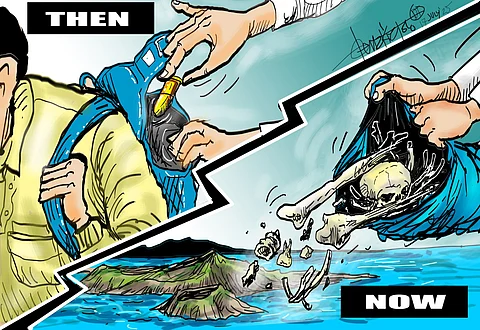
- NEWS
- the EDIT
- COMMENTARY
- BUSINESS
- LIFE
- SHOW
- ACTION
- GLOBAL GOALS
- SNAPS
- DYARYO TIRADA
- MORE

The phrase tanim bala once sent shivers down the spines of Filipino travelers, especially at the height of the airport scandal that shook the Ninoy Aquino International Airport (NAIA) a few years back.
It referred to the modus operandi of planting bullets in the luggage of unsuspecting passengers, supposedly to extort money or delay their travel. The term quickly became synonymous with government corruption, abuse of power, and the sheer brazenness of law enforcers entrusted to uphold the law.
Fast forward to today, and the public is once again raising eyebrows, this time over what many have dubbed tanim buto — the supposed planting of bones in Taal Lake as evidence in the long-running case of the missing sabungeros. It’s a case that has gripped the nation for over three years, filled with shady characters, gambling syndicates, police complicity, and now, perhaps, a touch of macabre theater.
The recent “discovery” of bones allegedly belonging to the missing cockfight enthusiasts beneath Taal Lake is seen by many as either a potential breakthrough or, more cynically, a desperate act to pin blame and finally close a case that has gone cold and politically inconvenient.
The skepticism is understandable. How can investigators claim authenticity after three years, with bodies submerged in a lake known for its volcanic activity and shifting underwater terrain? Even if the bones are proven to be human, can they be conclusively identified? Is this genuine evidence or another performance piece in a drawn-out investigation that has failed the victims’ families?
The term tanim buto emerges from a place of public frustration and deep distrust. The sabungeros’ disappearance was never just about missing persons — it revealed a disturbing nexus between law enforcers, gambling lords and political figures. In the initial stages, several cops were implicated. Allegations swirled that the sabungeros had seen or had participated in fixing online sabong results, putting them in the crosshairs of powerful interests. Over time, leads went cold, witnesses clammed up, and the scent of justice grew faint.
Now, with the sudden surfacing of bones, many fear a repeat of the old playbook: plant evidence to give the illusion of progress. Tanim bala was about coercion and quick cash. Tanim buto, if true, would be about closure by fabrication — serving a narrative instead of the truth. Worse, it could be an attempt to provide legal cover for the failure to find the real masterminds.
If the authorities truly want to regain the public’s trust, they must ensure scientific rigor in handling the bones — DNA testing, transparent documentation and open coordination with independent forensic experts. Otherwise, the perception will persist that justice is not only blind but is easily manipulated.
In the end, what connects tanim bala and tanim buto is a culture of impunity. Both expose how systems meant to protect can be twisted into tools of deception. Both show how easy it is to mock due process in the absence of accountability. And both remind us that when truth is buried — literally or figuratively — it is often the powerless who suffer the most.
So, are these bones a clue or a cover-up? The answer may lie not just beneath Taal Lake, but in the very soul of our justice system.
